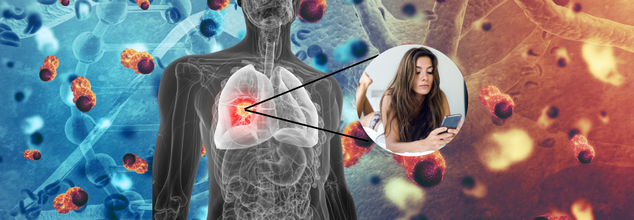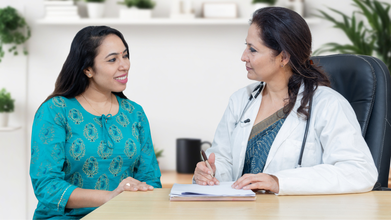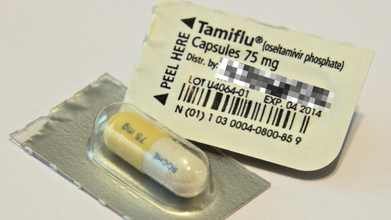- Health Conditions A-Z
- Health & Wellness
- Nutrition
- Fitness
- Health News
- Ayurveda
- Videos
- Medicine A-Z
- Parenting
Why Are Lifestyle Factors Making Millennials Vulnerable To Cancer?

Image Credit: Health and me
Cancer has been seen as a disease of aging, but now it is frightening statistics that reveal the rise of early-onset cancers among millennials. Estimates indicate that about 1.9 million people are newly diagnosed with cancer in the U.S. every year. This number will increase to 2.3 million by 2030. More and more studies are indicating that lifestyle disorders, such as an unhealthy diet, sedentary lifestyle, stress, and disrupted sleep patterns, may be a cause for which younger populations are increasingly becoming vulnerable to malignancies, including rare and aggressive types of cancer.
Has COVID-19 Worsened the Cancer Epidemic?
It has not been new news that viruses can provoke or accelerate cancer development, but research is still ongoing to understand the long-term impact of COVID-19 on cancer risk. What has already been determined, however, is that the pandemic indirectly worsened the outcomes of cancer. Delayed screenings, postponed treatments, and risks of increased mortality have all been noted globally.
The Lancet Public Health published research that underlines these consequences, indicating that the pandemic slowed or even reversed the declining cancer mortality rates observed before SARS-CoV-2 emerged. Delays in surgeries and chemotherapy treatments significantly impacted survival rates. For example, every four-week delay in colon cancer surgery increases the risk of death by 6%, while similar delays in adjuvant chemotherapy for colorectal cancer elevate mortality risk by 13%.
How Lifestyle Choices Are Driving Early-Onset Cancers
Dr. Priya Tiwari, Head of Medical Oncology, says that lifestyle choices play a critical role in the increasing incidence of cancer among young adults.
Poor diet rich in processed foods, high sugar, and red meat. Obesity and metabolic disorders are so closely linked with various cancers says Dr. Tiwari, "A sedentary lifestyle further compounds this risk, creating insulin resistance, vitamin D deficiency, and chronic inflammation, factors that are more strongly associated with colorectal and breast cancers,"
Susceptibility is further aggravated by tobacco usage, excessive alcohol consumption, and exposure to carcinogens. Stress and sleep deprivation also disrupt the balance of hormones and compromise immune function, leading to an environment conducive to tumorigenesis.
The association between stress, inflammation, and cancer.
Millennials face unprecedented levels of stress, driven by work pressures, financial instability, and excessive screen time. Chronic stress triggers the sustained release of cortisol and inflammatory cytokines such as IL-6 and TNF-α, which fuel systemic inflammation.
"Prolonged inflammation weakens immune surveillance, making the body less capable of detecting and eliminating cancerous cells before they grow uncontrollably," explains Dr. Tiwari.
The circadian rhythms have been disrupted due to late-night working hours and increased exposure to blue light. Decreased melatonin production, which is a natural cancer-fighting hormone, is associated with a higher incidence of hormone-related cancers, including breast and prostate cancer.
Are Rare and Aggressive Cancers on the Rise Post-Pandemic?
There is a rise in rare and aggressive cancers, which have been reported by medical experts post-pandemic, and possible reasons for this increase may include delayed screenings and lingering inflammatory effects from COVID-19. Many patients avoided routine health check-ups at the height of the pandemic, and this has led to late-stage diagnoses of malignancies like sarcomas, glioblastomas, and neuroendocrine tumors.
In addition, there is a theory that SARS-CoV-2 might have a part in tumor progression due to cytokine storms induced by interleukin-6 and tumor necrosis factor-alpha. This state of chronic inflammation might accelerate the growth of the tumor in predisposed individuals.
Should Millennials Start Cancer Screening Early?
Earlier, cancer screenings were typically recommended to the older people. However, with the increase of early-onset cancers among the young, screening guidelines have been revised for younger groups of populations. According to Dr. Tiwari, while universal screening is perhaps not required, screening should start earlier in cases of genetic predisposition or family cancer history.
Screening Requisiste includes:
1. Mammograms for women below 40 years of age who have a family history of breast cancers.
2. Colonoscopy for patients with a history of colorectal cancer in their family.
3. Pap smears and HPV tests for cervical cancer starting at age 21.
4. Skin exams for melanoma for those with increased sun exposure or family history.
How To Balance Lifestyle Choices And Reduce The Risk Of Developing Cancer?
Dr Priya emphasises, "A healthy lifestyle that includes nutrition, exercise, and stress management can prevent cancer in young adults. An antioxidant diet rich in fiber and omega-3 fatty acids decreases inflammation and protects against carcinogenesis. Exercise improves the regulation of insulin levels and inflammatory cytokines, thereby lowering risks of obesity-related cancers. Limiting tobacco and alcohol consumption as well as exposure to environmental toxins such as PAHs and endocrine disruptors can also reduce the risk of cancer further. Improved sleep hygiene, mindfulness for stress management, and other circadian rhythm-enhancing behaviors can also decrease the immunosuppressive effects of cortisol and therefore improve overall health."
Cancer prevention in young adults is only possible through preventive lifestyle changes. A healthy diet, regular exercise, stress control, and minimal exposure to known carcinogens will greatly reduce the risk of cancer. Here is a concise list of changes you should make now:
- Eat a Healthy Diet
- Increase antioxidant intake through foods such as berries, nuts, and leafy greens.
- Choose whole grains instead of refined carbohydrates.
- Use sources such as salmon, flaxseeds, and walnuts to increase intake of omega-3 fatty acids.
- Stay Physically Active
- Perform at least 150 minutes of moderate-intensity exercise weekly.
- Limit sedentary time for extended periods by incorporating moving activities during the day.
- Manage Stress in a Healthy Way
- Use mindfulness, which may include meditation and deep breathing, to manage the changes.
- Work-life boundaries can help alleviate chronic stress and prevent burnout.
- Improve Sleep Hygiene
- Reduce exposure to screens before bedtime to preserve melatonin.
- Develop sleep habits that allow for at least 7 to 9 hours of sleep each night.
- Limit Exposure to Hazardous Substances
- Cut back on alcohol consumption and quit smoking.
- Limit exposure to environmental toxins like PAHs and endocrine disruptors.
Increasing incidence of cancer in the millennial age group demands the need for urgent awareness and lifestyle changes. There is certainly a genetic contribution to cancer; however, lifestyle determinants, including diet, exercise, and management of stress, can all affect the course of cancer.
"Preventive care, including routine screenings and healthier lifestyle choices, holds the key to reducing the risk of cancer for young adults," said Dr. Tiwari. "Making conscious adjustments today will help millennials safeguard their health for tomorrow."
Since cancer trends continue to evolve, embracing proactive health measures, and then keeping prevention at par with treatment, will be imperative in reducing future burden caused by this disease.
Dr. Priya Tiwari is Head of Medical Oncology at Artemis Hospitals in India.
Five Essential Health Tests to Consider This Winter, According To A Doctor

Credits: iStock
Winter in India is often associated with sardio ke laddoo, but also with increasingly sedentary lifestyle, worsening air pollution, all of which leads to more time spending home than to going out, taking a stroll, working out and more. This is why as winter sets in, India also sees a quiet but consistent rise in non communicable diseases, or NCDs, conditions that now account for nearly two thirds of all deaths in the country. Heart disease, diabetes, thyroid disorders, fatty liver disease and arthritis continue to rise across age groups, driven by sedentary lifestyles, dietary excess and delayed diagnosis.
Winter can further aggravate these risks. Physical activity drops, calorie dense foods become routine, sunlight exposure reduces and metabolism changes. Studies and hospital data in India have repeatedly shown that heart attacks and strokes tend to spike during colder months. Blood vessels constrict, blood viscosity increases and cholesterol levels often rise. Blood sugar control also becomes more challenging, while joint pain and stiffness worsen for many.
Dr. Mayanka Lodha Seth, Chief Pathologist at Redcliffe Labs, says the problem is not seasonal food but seasonal neglect. “Traditional winter foods are not harmful on their own. The real risk comes from consuming them without understanding what is happening inside the body,” she explains. “Winter tends to mask symptoms while quietly worsening internal imbalances.”
With India already home to over 100 million people living with diabetes and a similar number estimated to be prediabetic, preventive testing becomes crucial. Doctors recommend five key tests that can offer a clearer picture of health before winter indulgence begins.
Blood Sugar Levels
Diabetes is one of the fastest growing NCDs in India, and a large proportion of cases remain undiagnosed. Winter diets high in sugar and fat can trigger frequent glucose spikes. Testing fasting blood sugar and HbA1c helps identify early risk and prevents long term complications affecting nerves, kidneys and the heart.
Lipid Profile
High cholesterol is a major contributor to cardiovascular disease, which remains India’s leading cause of death. Reduced activity in winter often pushes lipid levels higher. A lipid profile helps assess heart risk and guides dietary and lifestyle moderation before damage sets in.
Liver Function Test
Non alcoholic fatty liver disease is increasingly common in India, even among younger adults. Excess sugar and fat intake during winter can worsen liver fat accumulation. Early liver testing can flag reversible changes before they progress to chronic liver disease.
Thyroid Function Test
Thyroid disorders affect millions in India, especially women, and often go unnoticed. Symptoms like weight gain, fatigue and cold intolerance are frequently brushed off as winter sluggishness. A simple thyroid test helps distinguish seasonal lethargy from hormonal imbalance.
Vitamin D and Vitamin B12 Levels
Vitamin D deficiency is widespread due to limited sun exposure in winter, while Vitamin B12 deficiency remains common because of dietary patterns. Both deficiencies are linked to low immunity, muscle pain, bone weakness and worsening joint discomfort.
Dr. Seth adds, “Preventive diagnostic testing allows people to make informed choices. It helps them enjoy winter foods in moderation without unknowingly worsening an underlying condition.”
As NCD related healthcare costs continue to rise in India, early testing offers both health and financial protection. Winter comfort does not have to come at the cost of long term health. Staying informed may be the most effective preventive step this season.
Tamiflu Isn't The Only Flu Medicine, Expert Shares Other Alternative

Credits: iStock
Flu season is hitting hard this year, and the symptoms could feel relentless. People are suffering from rising fever, hacking cough, blocked and stuffy nose and sore throat. While many people get relief from Tamiflu, which is a prescribed antiviral medication that is used to treat or even to prevent illness, there are other alternatives available too.
Dr Ari Brown, a Texas based pediatrician and the author of Baby411 book series told CNN health that one of the most common complaints that she gets to hear from Tamiflu is vomiting. A 2023 study published in the Pediatric Infectious Disease Journal notes that 18% of people experienced vomiting with Tamiflu, as compared to 5% with Xofluza, an alternative.
“I’ve also had a few pediatric patients experience moodiness with Tamiflu, which is reported in the literature,” she said.
Read: Adenovirus Cases Rise In UK, Health Authorities On Alert
Tamiflu is usually gives to treat flu in people ages 2 weeks and older and to reduce the chance of getting the flu in people 1 year and older. The medicine could be administered in both form, liquid and capsules and usually taken twice daily for five days straight. This is prescribed for when flu is to be treated. However, when used for prevention, it is typically taken once for 10 days.
What Are The Other Alternatives Available For Flu Treatment?
Xofluza: It is administered as a single dose tablet and is approved for ages 5 and older. This medicine can also be used to treat or to prevent the flu. While it costs nearly $200 for those without insurance, eligible patients can use coupons to lessen costs. Dr Brown points out that this medicine could have side effects like diarrhea and vomiting. However, the study aforementioned notes that for this, only 5% patients had vomiting symptoms, when compared with Tamiflu.
Dr Brown also said that Xofluza can stop viral shedding in one day, while Tamiflu could take up to three days. "Both antivirals will help reduce the duration of misery by couple of days," she pointed out.
Dr Brown also pointed out that overall, "Xofluza is rising in popularity over Tamiflu." “One dose. Fewer side effects. More insurances are covering the cost of it now and manufacturer coupon makes it less expensive than in previous years," she said.
Rapivab: This is another prescribed medication that is approved to treat flu. This could be administered for people ages 6 months and older. It has to be given by a health care provider, as it is given once as an intravenous infusion. It could cost up to $1,000 without insurance and most common reaction in adults is diarrhea.
Relenza: This flu medication is inhaled in powder form. It is administered through an inhaler device, which is to be used twice a day for five days straight. The prescribed drug is approved to treat flu in ages 7 and older and for preventative use, in ages 5 and older. It could cost about $90 without insurance.
It may have side effects like dizziness, allergic reaction, or irritation of the nose. It is not recommended for people who have breathing issues or have asthma.
How To Cure Hangover Headache At Home?

Credits: Canva
Hangover headaches are miserable. Most people know that drinking too much alcohol can leave you with a long list of next-day problems, and a headache is one of the most common. You will find no shortage of so-called hangover headache “fixes” online, in home remedies, and even on store shelves. The problem is that very few of them are backed by solid scientific evidence. The surest way to prevent a hangover headache is to watch how much alcohol you drink at one time. That said, there are a few simple, home-based steps that may lower your risk of waking up with a headache, and some practical ways to manage the pain if it has already set in.
What Is A Hangover?
A hangover refers to the uncomfortable physical and mental effects you experience after drinking too much alcohol the night before. According to the Cleveland Clinic, hangovers are extremely common among people who overdrink. One study found that nearly 75% of people who consumed excessive alcohol reported hangover symptoms the following day. The same research suggested that about 25% to 30% of drinkers may not experience hangovers at all.
How Much Alcohol Does It Take To Get A Hangover?
Drinking more than one alcoholic beverage per hour can lead to a hangover. Your body generally needs about an hour to break down and process a single drink. As explained by the Cleveland Clinic, one drink is roughly equal to:
- One 12-ounce can of regular or light beer (5% alcohol).
- Half a pint, or about 8 to 9 ounces, of malt liquor or many craft beers (7% alcohol).
- One 5-ounce glass of table wine (12% alcohol).
- One shot, or 1.5 ounces, of liquor (40% alcohol).
How To Cure Hangover Headache At Home?
Many products and home remedies claim they can cure a hangover, but most are not supported by science, and some may even do harm. For instance, having more alcohol the next morning does not fix a hangover. It simply adds more toxins to your system.
Instead, consider these self-care measures for hangover relief:
- Eat simple foods with complex carbohydrates, such as toast or crackers. These can help raise low blood sugar levels and ease nausea.
- Drink plenty of fluids. Water, electrolyte drinks like Gatorade® or Pedialyte®, broth, and other non-alcoholic beverages can help counter dehydration. A good sign you are rehydrated is when your urine becomes clear.
- Get adequate sleep to help your body recover from fatigue.
- Use antacids to calm stomach discomfort.
Consider aspirin or other nonsteroidal anti-inflammatory drugs (NSAIDs) such as ibuprofen or naproxen to relieve aches and pains. NSAIDs are generally the most effective medications for hangover-related pain, but they should be used cautiously because they can irritate your stomach. Avoid acetaminophen (Tylenol), as combining it with alcohol can damage your liver.
Give it time. Hangover symptoms usually improve within eight to 24 hours. During this period, your body works to eliminate alcohol toxins, restore hydration, repair tissues, and return normal body functions to baseline.
© 2024 Bennett, Coleman & Company Limited

